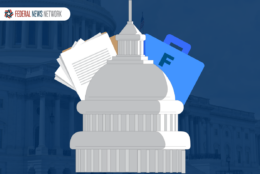
The president’s budget and the civil service
Guest columnist Jeff Neal says there is not a lot of room on the congressional calendar this fiscal year to have a serious discussion about civil service issues.
This column was originally published on Jeff Neal’s blog, ChiefHRO.com, and was republished here with permission from the author.
On Monday the White House released the President’s Budget proposal for 2020. So what is in there for public servants? Here are the key proposals that could effect the federal workforce if they were implemented:
Cybersecurity workforce
The Office of Management and Budget, the Department of Homeland Security and all federal agencies are working to “establish a unified cyber workforce capability across the civilian enterprise.” The government’s hiring issues are particularly problematic in occupations such as cyber, where pay flexibility and the antiquated government hiring rules make it difficult for government to recruit and retain talent.
The recently established Federal Cybersecurity Reskilling Academy project is one example of changes that are under way. Although it is too early to know how well it will work, it is a good example of how thinking differently may provide proof that reskilling the government’s existing workforce is an effective means of meeting some of the talent needs.
Freeze federal pay
For the second year in a row, the budget proposes freezing federal pay. Last year’s proposal included the same thing, but the deal that ended the partial shutdown provided a 1.9 percent pay raise. It is a good bet that whatever deal is reached this year will also include a pay raise. Federal employees vote and 2020 is an election year. It is too early to make an accurate projection of the amount, but the odds are very much in favor of a pay raise.
Retirement cuts
The proposal includes a number of changes to federal retirement benefits. They include:
- Eliminating annual cost of living adjustments for Federal Employees Retirement System participants and reducing them by .5 percent for Civil Service Retirement System participants
- Eliminating the FERS Special Retirement Supplement
- Increasing employee contributions to 50 percent of costs, phased in at 1 percent per year
- Implementing a defined contribution program for term employees
- Changing the retirement calculation from high-three to high-five, and
- Reducing the Thrift Savings Plan G Fund interest rate.
Most of the retirement changes will not be popular with employees, are unlikely to pass the House and might not fare much better in the Senate. That does not mean retirement changes will never happen. As fewer and fewer private sector employees are covered by defined benefit pensions and have defined contribution plans such as 401K and similar plans, support for public employee pension programs is likely to shrink.
At some point we will see some of these proposals resurface and pass. The increase to a high-five calculation is the most likely to pass first, because its effects play out over a longer term.
One question I get every time these types of proposals surface is “Should I retire now to lock in my benefits?” My answer is no. As you can see from these proposals, even current retirees may be affected by some changes. My recommendation to federal employees is to retire when you planned to retire and do not make any decisions based on proposals that are unlikely to pass any time soon.
Dramatically cut civilian agency budgets
The proposal includes cuts of 10 percent or more in the departments of Agriculture, Education, Energy, Health and Human Services, Housing and Urban Development, Interior, State and Transportation, as well as in the Environmental Protection Agency. Cuts of that magnitude would most likely lead to workforce reductions, although it might be possible to do them with a combination of buyouts and early retirement. These proposals are not new and faced bipartisan rejection last year. There is no reason to believe this year will be different.
Eliminate the Office of Personnel Management
The Government Reorganization Fact Sheet that accompanies the 2020 budget proposal clarifies the proposed fate of OPM. It calls for a “full reorganization” and “transferring elements of workforce policy and strategy functions to the Executive Office of the President” and “transferring the conduct of background investigations functions to the Department of Defense.” It includes “transferring all remaining functions to the General Services Administration, including oversight and transactional functions from OPM’s Human Resources Solutions, Retirement Services, Healthcare and Insurance, Office of Inspector General, and Merit System Accountability and Compliance organizations.”
Although the proposal does not explicitly call for eliminating OPM, once it is done, there is nothing left to do at OPM other than turning out the lights. How likely is it that it will happen? The background investigation part of the proposal is happening and plans are under way for the HRS work to transfer during fiscal 2019. Although it is still unclear if the move will involve a move of OPM’s working capital fund to GSA, or if folding HRS into one of the existing GSA working capital funds. The HRS move might be possible without congressional approval, but it is unlikely the rest of the proposed changes can be carried out without changing the law.
More from Jeff Neal
“The last thing we need to keep in mind is that OPM is not the primary guardian of the merit-based civil service. The real guardian is Congress. The merit system principles are not OPM regulations — they are law. The prohibited personnel practices are law. The protections from removal without due process are law and constitutional. Reorganizing OPM or creating the civil service equivalent of Office of Federal Procurement Policy does not change that.
“We have had 40 years of OPM as it currently exists. Before that we had 93 years of the Civil Service Commission not counting the two years the CSC existed in the 1870s. Neither OPM nor the Civil Service Commission were perfect and both had their critics. Is the administration’s proposal what I would choose if it were up to me? Probably not. Is it the death knell of the civil service? No. As a matter of fact, having civil service policy reside in EOP was one of the approaches that was considered in writing the Civil Service Reform Act of 1978.
“I say let the administration try their proposed arrangement. If it works, Congress can codify it and make it permanent. If not, Congress can more clearly codify the role of OPM and undo it. There is little likelihood that it will create any problems that cannot be fixed.”
My views have not changed. OPM’s unresponsiveness on policy matters is the root cause of proposals to eliminate it. The agency can take years to issue regulations following statutory changes. They often take the most restrictive and inflexible possible interpretation of the meaning of civil service laws. And they do not have a history of being forward thinking or responsive to agency needs on workforce policy matters. When innovators — yes, they have innovative people — within OPM want to change the way the agency does business, the establishment within OPM often shuts them down.
In the past 10 years I have been involved in many discussions with people on both sides of the political spectrum where the issue of what to do with OPM was on the table. Both Democrats and Republicans have discussed the idea of moving much of OPM into GSA. I know that such proposals were discussed when I served in the Obama administration and by the Hillary Clinton campaign.
Latest Workforce News
Concluding thoughts
The government appropriations process is so broken that every year the President’s Budget is declared dead on arrival. Even when the same party controls the White House, House of Representatives and Senate, it is not much better. The details of the budget proposal are important because some parts may make it into the final authorization and appropriations bills. This year, the process is likely to be overshadowed by the 2020 elections, the fight over the border wall, and the balance between defense and domestic spending.
There is not a lot of room on the congressional calendar in the 201 days remaining in this fiscal year to have a serious discussion about civil service issues. We certainly will not see comprehensive civil service reform. We are unlikely to see pay reform, hiring reform, or any other complex federal workforce issues resolved. There is so much disagreement about those issues that even in the best of times they are difficult. The bottom line? The status quo wins again.
Jeff Neal is a senior vice president for ICF and founder of the blog, ChiefHRO.com. Before coming to ICF, Neal was the chief human capital officer at the Homeland Security Department and the chief human resources officer at the Defense Logistics Agency.
Copyright © 2025 Federal News Network. All rights reserved. This website is not intended for users located within the European Economic Area.






